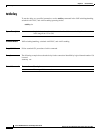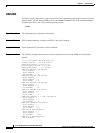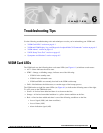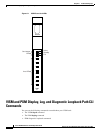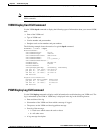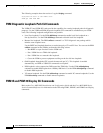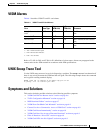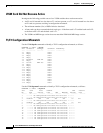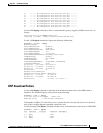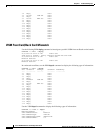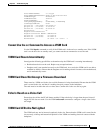
6-3
Cisco VISM Installation and Configuration Guide
Release 3.0, Part Number OL-2521-01 Rev. D0, June 2004
Chapter 6 Troubleshooting Tips
VISM and PXM Display, Log, and Diagnostic Loopback Path CLI Commands
Note Refer to the Cisco MGX 8000 Series platform command reference guides for more information on
PXM commands.
VISM Display Card CLI Command
Use the VISM dspcd command to display the following types of information about your current VISM
card:
• State of the VISM card
• Type of VISM card
• Version number and part numbers
• Daughter card version numbers and part numbers
The following example shows the results of a typical dspcd command:
NODENAME.1.3.VISM8.a > dspcd
ModuleSlotNumber: 17
FunctionModuleState: Active
FunctionModuleType: VISM-8T1
FunctionModuleSerialNum: SAK0331006P
FunctionModuleHWRev: 0.0
FunctionModuleFWRev: 2.0.0_11Nov01_2
FunctionModuleResetReason: ?
LineModuleType: LM-RJ48-8T1
LineModuleState: Present
mibVersionNumber: 21
configChangeTypeBitMap: CardCnfChng, LineCnfChng
pcb part no - (800 level): 800-04399-01
pcb part no - (73 level): 73-03618-01
Fab Part no - (28 level): 28-02791-01
PCB Revision: 08
Daughter Card Information:
Daughter Card Serial Number: SAK0331003P
pcb part no - (73 level): 73-03722-01
Fab Part no - (28 level): 28-02905-01
PCB Revision: 04
PXM Display Log CLI Command
Use the PXM dsplog command to display useful information for troubleshooting your VISM card. The
log is maintained by the PXM. A VISM entry is displayed in the log in the following format:
• Date and time of the log
• Slot number of the VISM card from which a message is logged
• The process on the VISM card that logged that message
• Severity of the message:
–
1 = Fatal error which causes the card to reboot
–
6 = All other errors
• A log message description




